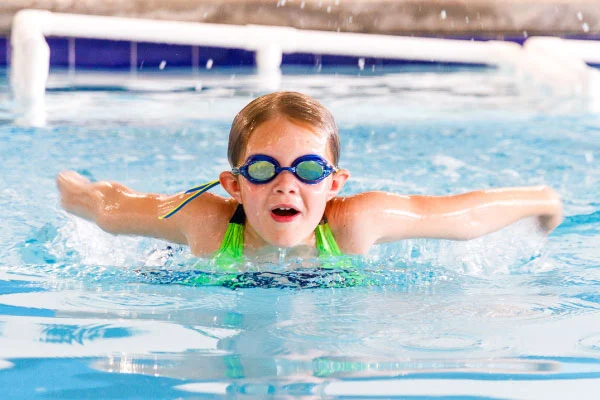Swimming is an exceptional full-body exercise, combining cardiovascular endurance, strength, and flexibility in one powerful workout. Whether you’re just starting out and looking to improve your lap times, or you’re a seasoned swimmer working to refine your stroke technique, there are several strategies you can implement to increase your speed in the pool. By paying attention to elements like form, strength, and overall conditioning, you can significantly reduce your swim times and glide through the water more efficiently. Below are some helpful tips and drills to enhance your swimming performance.
1. Prioritize a Streamlined Body Position
Reducing water resistance is crucial for swimming faster. The more streamlined your body, the less drag you’ll encounter, enabling smoother movement through the water. Here are a few tips to perfect your body position:
- Maintain a Straight Line: Your body should form a continuous line from head to toe. A streamlined position minimizes drag, allowing for a more efficient glide through the water.
- Keep Your Head Neutral: Avoid lifting your head too much, as this can cause your body to rise in the water and increase resistance. A neutral head position, aligned with your spine, helps reduce drag.
- Engage Your Core: A strong core stabilizes your body, helping you maintain proper form and reducing energy wastage as you swim.
2. Perfect Your Technique with Specific Drills
Improving your swimming technique is essential for swimming faster. Here are a few drills to help you enhance your stroke and overall technique:
- Catch-Up Drill: This drill encourages proper stroke mechanics. Swim freestyle and pause your lead arm in front of you before pulling with the other arm to meet it. This helps you focus on efficient arm recovery and maintaining a streamlined body position.
- Single Arm Freestyle Drill: Swim with one arm while keeping the other extended or resting by your side. Alternate arms. This drill improves arm strength, body rotation, and breathing coordination.
- 3-3-3 Drill: Swim three strokes with your right arm, three with your left arm, and then three with both arms. This promotes better body rotation and efficient breathing patterns.
- Sculling Drill: Keep your arms extended and perform small, controlled sculling motions. This strengthens your hand positioning and improves your ability to “feel” the water during the pull phase of each stroke.
3. Strengthen Your Kick
A powerful, consistent kick is essential for increasing speed in the water. Here are a few exercises to build your kick strength:
- Vertical Kicking: Practice kicking while standing upright in the deep end. This challenges your core and leg muscles, developing both strength and endurance for your kicks.
- Kickboard Kicking: Use a kickboard to isolate your legs. Focus on a steady rhythm, kicking from your hips rather than just your knees, and work on maintaining a streamlined body position.
- Flutter Kick: The flutter kick is fundamental for freestyle swimming. Ensure your kick is quick and consistent, keeping your legs relaxed and minimizing splashing. Focus on a smooth, rhythmic cadence instead of forceful kicks.
4. Improve Your Breathing
Efficient breathing is crucial for swimming faster. Poor breathing mechanics can disrupt your rhythm and slow you down. Here’s how to enhance your breathing technique:
- Bilateral Breathing: Learn to breathe on both sides, alternating with each stroke. This ensures even body rotation and better stroke balance.
- Breath Timing: When you breathe, rotate your body slightly to your side instead of lifting your head too much. A smooth, controlled breath allows you to stay aligned while maintaining your rhythm.
- Exhale Continuously: Breathe out steadily underwater to avoid holding your breath. A controlled exhale enables a quicker, more efficient inhale when you rotate your head to take a breath.
5. Build Strength and Endurance
To swim faster, you need both strength and endurance. Regular strength training and conditioning exercises will help you develop the necessary muscle power and stamina:
- Strength Training: Incorporate exercises like squats, lunges, deadlifts, and planks into your routine. These exercises target the key muscles used in swimming, enhancing both power and endurance.
- Plyometric Exercises: Incorporating explosive exercises like box jumps or jump squats will increase the strength and speed of your kicks and strokes by engaging fast-twitch muscle fibers.
- Endurance Work: Swim longer distances at a moderate pace to build endurance, and add interval training with sprints followed by short rest periods to improve cardiovascular fitness.
6. Increase Stroke Rate (SWOLF)
Improving your stroke rate while maintaining proper form can help you swim faster. SWOLF (Stroke Length + Stroke Time) measures your swimming efficiency. Here’s how you can improve it:
- Track SWOLF: The lower your SWOLF score, the more efficient your swimming. Focus on increasing your stroke rate while maintaining fluid, controlled movements.
- Interval Training: Add interval sets to your routine, where you swim short bursts of speed followed by recovery periods. This will help you increase your stroke rate without sacrificing form.
7. Master Starts and Turns
Starts and turns play a huge role in reducing your overall swim time. Quick, powerful starts and efficient turns can shave valuable seconds off your performance.
- Flip Turns: Flip turns are one of the most efficient ways to change direction while minimizing time loss. Practice the technique to perfect your body position and push-off.
- Strong Starts: Focus on explosive starts from the block, utilizing a powerful push and a streamlined dive into the water. A strong start can give you a competitive edge.
By incorporating these tips and drills into your swimming routine, you can build a faster, more efficient stroke. Consistent practice and focus on your form, strength, and technique will enable you to improve your speed in the pool and reach your swimming goals.

Tinggalkan Balasan